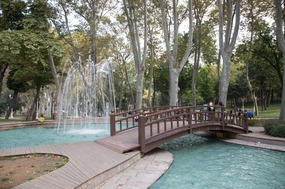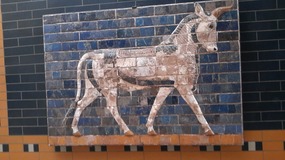Sept 11…..Discovering Istanbul
We woke up refreshed and, after a hearty breakfast, were ready to start discovering Istanbul
. My travel consultant, extraordinaire, had figured out the exact route we needed to take on the metro to get us to the old part of town. We arrived with ease and found ourselves at the entrance to Gulhane Park, the oldest public park in Istanbul. One could walk through the park to arrive at both the Topkapi Palace, that we had visited five years earlier when we were in Istanbul for only two days, as well as the Istanbul Archaeology Museum, the city's top museum attraction, which was where we were headed.
When we arrived and entered the Museum of the Ancient Orient we, erroneously, thought that this massive 1883 building, filled with a collection of pre-Islamic items gathered from the expanse of the Ottoman Empire, WAS the entire Archaeology Museum. We marveled at the series of large blue and yellow glazed brick panels depicting real and mythical animals such as lions, dragons and bulls, that once lined the processional street and the Ishtar gate of ancient Babylon. The antiquity of the statues and fragments was mind boggling, particularly two fragmentary tablets, written in the cuneiform script, one of the earliest systems of writing, that dated to around 1700 BC
. We got scolded by one of the museum people for taking a photo of Bill leaning against one of the ancient statues. I had to laugh at the thought of them thinking that the statue would somehow be damaged by Bill touching it when it had survived for thousands of years. However, I admit, it probably was bad decorum.
When we were finished viewing what we thought was the whole museum, we were stunned to discover that it actually consists of three separate buildings: the Museum of the Ancient Orient, the Archaeology Museum and the Tiled Pavilion. These three museums, combined, house the palace collections formed during the late 19th century and include exhibits displaying ancient artefacts, classical statuary and an excellent exhibit that conveys the staggering history of this metropolis, from the legend of its founding right up to the Ottoman era.
We were already in a state of sensory overload but there was no way we could not visit the other two buildings
. The next museum we viewed was the magnificent Tiled Pavilion, which is one of the oldest surviving Ottoman buildings in Istanbul. Built in 1472 and wonderfully preserved, the architecture shows a clear Persian influence. It was originally built for Sultan Mehmet the Conqueror as a rather grand spot for him to watch games and sports. The displays were filled with gorgeous Iznik pottery and tiles. This decorated style of ceramic is named after the town in western Anatolia where it was made and was produced from the last quarter of the 15th century until the end of the 17th century. The meticulous designs and vibrant cobalt blue color combined traditional Ottoman arabesque patterns with Chinese elements.
Across from the Tiled Pavilion was the Archaeology Museum, and the final building in the museum complex. We didn’t think it was open, as part of the imposing neo-classical building was wrapped in scaffolding and tarpaulin as it was undergoing some renovation. It was open, however, and we did find a passageway into the museum and, after spending another few hours viewing the extensive collection of classical statuary and a sprawling exhibit documenting Istanbul’s history, our sensory overload reached new heights when we went through a separate entrance which led to an impressive collection of ancient grave-cult sarcophagi from Syria, Lebanon, Thessalonica and Ephesus and, the museum’s major treasures, the sarcophagi from Sidon, unearthed in 1887 by Osman Hamdi Bey
. Unfortunately, the two most famous of the collection, Alexander Sarcophagus and Mourning Women Sarcophagus weren’t on display during the renovation. Even without these two masterpieces, we were completely blown away by the detailed stelae (stone slabs, erected as a monument for commemorative purposes), and the sarcophagi that were on display, most dating from between 140 and 270 AD. The one that was beyond belief was the Sidamara Sarcophagus from Konya that was carved from one huge piece of marble. We must have circled this gigantic monument, that looked like a tiny temple, twenty times, trying to figure out how it could possibly have been carved from one massive piece of marble. All four sides were filled with detailed figures, standing or reclining, in flowing robes, warriors on horses with interlocking legs as well as lions and other beasts, and playful cherubs adorning the lid of the sarcophagus. Neither of us had ever seen anything like it and we left the last building of the museum complex exhausted and in a state of awe.
SENSORY OVERLOAD
Sunday, September 11, 2016
 Istanbul, Istanbul, Turkey
Istanbul, Istanbul, Turkey
Other Entries
-
23FINALLY IN A NEW COUNTRY
Aug 1824 days prior Vienna, Austriaphoto_camera24videocam 0comment 4
Vienna, Austriaphoto_camera24videocam 0comment 4 -
24ALBERTINA, SCHONBRUNN AND THE FABULOUS ZOO
Aug 1923 days prior Vienna, Austriaphoto_camera29videocam 1comment 3
Vienna, Austriaphoto_camera29videocam 1comment 3 -
25SO MUCH TO SEE AND DO....AND IT'S PAM'S BIRTHDAY
Aug 2022 days prior Vienna, Austriaphoto_camera46videocam 0comment 1
Vienna, Austriaphoto_camera46videocam 0comment 1 -
26MORE SIGHTS TO SEE ON ROD'S BIRTHDAY
Aug 2121 days prior Vienna, Austriaphoto_camera24videocam 0comment 0
Vienna, Austriaphoto_camera24videocam 0comment 0 -
27OUR FINAL FULL DAY IN VIENNA
Aug 2220 days prior Vienna, Austriaphoto_camera16videocam 0comment 1
Vienna, Austriaphoto_camera16videocam 0comment 1 -
28A NEW ADVENTURE....A NEW COUNTRY
Aug 2319 days prior Yastrebets, Russian Federationphoto_camera47videocam 1comment 1
Yastrebets, Russian Federationphoto_camera47videocam 1comment 1 -
29NOW WE'RE IN ROMANIA...WE SURE GET AROUND
Aug 2616 days prior Brasov, Romaniaphoto_camera22videocam 0comment 4
Brasov, Romaniaphoto_camera22videocam 0comment 4 -
30WALKING TOUR IN BRASOV
Aug 2715 days prior Brasov, Romaniaphoto_camera18videocam 0comment 0
Brasov, Romaniaphoto_camera18videocam 0comment 0 -
31ALL I CAN SAY IS.....BIZARRE
Aug 2814 days prior Sacele, Romaniaphoto_camera18videocam 0comment 2
Sacele, Romaniaphoto_camera18videocam 0comment 2 -
32PHOTO JOURNAL OF OUR SACELE HOME EXCHANGE
Aug 2913 days prior Săcele, Romaniaphoto_camera18videocam 0comment 5
Săcele, Romaniaphoto_camera18videocam 0comment 5 -
33VISITING THE LOVELY TOWN OF SINAIA
Aug 3012 days prior Sinaia, Romaniaphoto_camera26videocam 0comment 1
Sinaia, Romaniaphoto_camera26videocam 0comment 1 -
34OCTOBERFEST, SIGHISOARA THEN THE BLACK SEA
Aug 3111 days prior Sighisoara, Romaniaphoto_camera39videocam 0comment 3
Sighisoara, Romaniaphoto_camera39videocam 0comment 3 -
35ANOTHER COUNTRY, ANOTHER HOME EXCHANGE
Sep 029 days prior Kosharitsa, Bulgariaphoto_camera29videocam 0comment 2
Kosharitsa, Bulgariaphoto_camera29videocam 0comment 2 -
36THE ENCHANTING VILLAGE OF SOZOPOL
Sep 047 days prior Sozopol, Bulgariaphoto_camera34videocam 0comment 4
Sozopol, Bulgariaphoto_camera34videocam 0comment 4 -
37WE'RE ON OUR OWN
Sep 065 days prior Sveti Vlas, Bulgariaphoto_camera12videocam 0comment 2
Sveti Vlas, Bulgariaphoto_camera12videocam 0comment 2 -
38LAST FEW DAYS IN EASTERN EUROPE
Sep 074 days prior Sveti Vlas, Bulgariaphoto_camera21videocam 0comment 6
Sveti Vlas, Bulgariaphoto_camera21videocam 0comment 6 -
39MYSTERY OF THE MISSING LUGGAGE
Sep 101 day prior Istanbul, Turkeyphoto_camera5videocam 0comment 1
Istanbul, Turkeyphoto_camera5videocam 0comment 1 -
40SENSORY OVERLOAD
Sep 11 Istanbul, Turkeyphoto_camera31videocam 0comment 9
Istanbul, Turkeyphoto_camera31videocam 0comment 9 -
41TAKSIM SQUARE AND THE POTATO SEARCH
Sep 121 day later Istanbul, Turkeyphoto_camera34videocam 0comment 3
Istanbul, Turkeyphoto_camera34videocam 0comment 3 -
42MAYBE THIS IS WHAT IT LOOKS LIKE ON THE MOON
Sep 132 days later Nevsehir, Turkeyphoto_camera29videocam 1comment 6
Nevsehir, Turkeyphoto_camera29videocam 1comment 6 -
43DAY TWO - CAPPADOCIA
Sep 143 days later Nevsehir, Turkeyphoto_camera32videocam 0comment 5
Nevsehir, Turkeyphoto_camera32videocam 0comment 5 -
44LAST TWO DAYS IN ISTANBUL
Sep 154 days later Istanbul, Turkeyphoto_camera29videocam 0comment 3
Istanbul, Turkeyphoto_camera29videocam 0comment 3 -
45CAIRO AND OUR FABULOUS NILE RIVER CRUISE
Sep 176 days later Cairo, Egyptphoto_camera24videocam 0comment 5
Cairo, Egyptphoto_camera24videocam 0comment 5 -
46OUR NILE EXCURSION CONTINUES
Sep 198 days later Luxor, Egyptphoto_camera35videocam 0comment 6
Luxor, Egyptphoto_camera35videocam 0comment 6 -
47VALLEY OF THE KINGS
Sep 209 days later Luxor, Egyptphoto_camera34videocam 0comment 8
Luxor, Egyptphoto_camera34videocam 0comment 8 -
48EDFU AND KOM OMBO
Sep 2110 days later Aswān, Egyptphoto_camera36videocam 0comment 5
Aswān, Egyptphoto_camera36videocam 0comment 5 -
49OUR LAST FULL DAY ON THE NILE EXCURSION
Sep 2211 days later Aswān, Egyptphoto_camera32videocam 0comment 4
Aswān, Egyptphoto_camera32videocam 0comment 4 -
50THE AIRPORT FIASCO
Sep 2312 days later Addis Ababa, Ethiopiaphoto_camera23videocam 0comment 4
Addis Ababa, Ethiopiaphoto_camera23videocam 0comment 4 -
51THE MESKEL FESTIVAL
Sep 2615 days later Addis Ababa, Ethiopiaphoto_camera29videocam 4comment 1
Addis Ababa, Ethiopiaphoto_camera29videocam 4comment 1 -
52THE ASTOUNDING CHURCHES OF LALIBELA
Sep 2817 days later Lalibela, Ethiopiaphoto_camera42videocam 0comment 2
Lalibela, Ethiopiaphoto_camera42videocam 0comment 2 -
53OUR NEW SON
Sep 2918 days later Lalibela, Ethiopiaphoto_camera39videocam 1comment 4
Lalibela, Ethiopiaphoto_camera39videocam 1comment 4 -
54BACK TO ADDIS ABABA
Sep 3019 days later Addis Ababa, Ethiopiaphoto_camera30videocam 3comment 2
Addis Ababa, Ethiopiaphoto_camera30videocam 3comment 2 -
55FINALLY.....THE ANIMALS!!!!
Oct 0322 days later Nairobi, Kenyaphoto_camera51videocam 2comment 6
Nairobi, Kenyaphoto_camera51videocam 2comment 6 -
56MORE SAFARI THEN BACK TO NAIROBI
Oct 06390 days later Lake Nakuru National Park, Kenyaphoto_camera35videocam 0comment 1
Lake Nakuru National Park, Kenyaphoto_camera35videocam 0comment 1 -
57FABULOUS HOME EXCHANGE IN DEBASO, KENYA
Oct 09393 days later Malindi, Kenyaphoto_camera29videocam 0comment 5
Malindi, Kenyaphoto_camera29videocam 0comment 5 -
58UNWINDING IN PARADISE
Oct 10394 days later Watamu, Kenyaphoto_camera25videocam 0comment 3
Watamu, Kenyaphoto_camera25videocam 0comment 3

 Istanbul, Istanbul, Turkey
Istanbul, Istanbul, Turkey






































2025-05-22